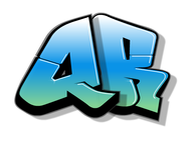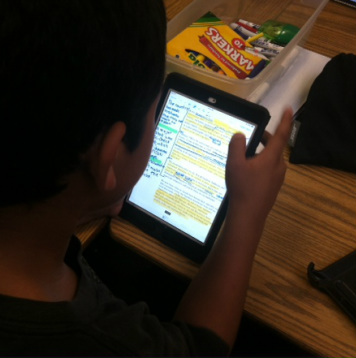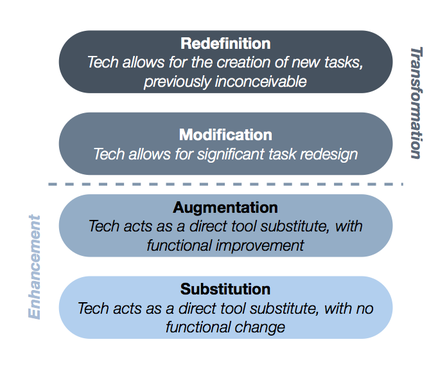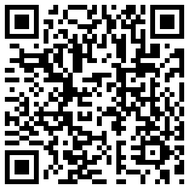|
Teaching in a technology-rich environment is nothing new to me. I've taught a variety of 1:1 and 2:1 programs, and last year my classroom was one of three in PSUSD where students were allowed to BYOD. Our small pilot launched officially in November of last year, and we spent the first two months of school in a 1:1 environment using school site resources (carts of iPads and iPods) to prepare students for the rollout. The program was wildly successful, and this year PSUSD has opened up the Year Two BYOD Pilot to even more classrooms across the district. Awesome! Fast forward to five weeks ago. I was thrilled to send home the BYOD permission form with my parent letter on the first day of school. I couldn't wait for year two of the pilot to begin! As an added challenge, and because I am clearly someone who doesn't shy away from possibly biting off more than they can chew, I decided that this year my BYOD implementation would go from paper lite to paperless as an education experiment of sorts. (To my knowledge, there are currently no other entirely paperless classrooms anywhere else in my district.) Though I toyed with the notion of having kids ask their parents to visit a virtual copy of the letter so I wouldn't have to print any, I ended up biting the bullet and running off copies since 30% of my students do not have Internet access, 88% of them qualify as socio-economically disadvantaged, and some only speak Spanish. I swore that the parent letter would be the ONE copy I'd make all year, and happily punched in my copy code. It was a good decision because BYOD permission forms came rolling in, and starting on the second day of school, kids brought their own devices and started tapping into our school's wifi. Anyone who knows me personally or professionally knows that I am a planner. I am excited by impromptu activities and unafraid to take a rabbit trail during learning, but I definitely give lots of conscientious thought to rolling out technology in my classroom each year. So, why then, did the first month of school seem so much like nightmare stay in Purgatory, sans the elevator music and white waiting room motif I've always imagined? Let me just say this: BYOD teachers live in a constant state of problem-solving, unlike any other 1:1 environment. There were moments during the first month that, if I were a different woman and not PACKwoman, I absolutely would have given in. In retrospect, the really killer aspect of teaching and learning with BYOD is the fact that each set of instructions need to be given several times for several different platforms. During the first days of school, students are trapped in the learning curve - which is HUGE - as they try to become comfortable working in the tech zone. Now, I can reflect and say that starting last year's rollout with a universal platform really helped. Students who have the most difficulty adjusting are those who have little or no previous experience with technology. The term "digital native" is misleading, because students absolutely have to be taught to utilize their devices for educative purposes, which is not something that comes naturally. Knowing how to be entertained with an iPhone is easy, sure. Knowing how to complete assignments, cite information, search effectively, and generate quality content is a whole other skill set.
I think it's important to note that one of the underlying issues in this whole scenario is much more than tech trouble. More than any other year, this particular group of kids seems to lack autonomy. They are 100% the product of high-stakes testing. Getting them to feel comfortable enough to break free, experiment, problem-solve, and think outside the box is going to be the biggest challenge of all. I have no doubt my students will eventually be able to get there; it's just a matter of how much time it will take. This is probably the part where I should affirm, I do have hope! Last week was our fifth week of school, and this much is true: good things come to those who wait. As I looked around the room at the end of the first block of students on Tuesday morning, I was struck by a single thought: "Success." All 39 students had successfully logged in to Google Drive. They had successfully completed a close reading activity in eBackpack, podcasted on AudioBoo, made a mind map in Skitch, and responded to prompts with Socrative. The rest of last week coasted by with only positive results. I am still sighing in relief. Do you have any BYOD or paperless tips? Comment below or hit me up on Twitter to continue the conversation.
0 Comments
 As election season creeps up on us like a herd of thundering rhinoceroses, I am constantly reminded by CTA that I should vote to support education (no kidding?), reminded by the district that our situation will become dire unless much needed fiscal relief arrives in the form of propositions passed (is this how Marie Antoinette felt pre-guillotine slice?), and reminded by my wallet that I really need a bigger classroom budget if I’m going to pull off the 2012-2013 school year. As the budget gap widens in the state of California, educators are getting more and more creative about how they get things done. I’m pretty sure I’ve even seen this guy wandering in and out of the staff room at my school site: In the last month, I’ve heard district office administrators recommend that school sites begin devoting more funds toward the purchase of technology, because of the impending shift to Common Core. Ironically, I’ve also heard school site administrators say that the district office will have to devote more funds toward the purchase of technology. (Did you catch that swinging door of pass-the-buck responsibility?) And now, the latest and greatest plan is to shift the responsibility for tech purchasing onto students themselves by launching a student-centered BYOD program. I’ll be honest: At the moment, I have a somewhat Jekyll and Hyde relationship with the concept of BYOD. While I enthusiastically embrace BYOD based on the fact that it will allow my students to have a 1:1 tech access, I also recognize that there are definite limitations to the transformative impact of BYOD. Take, for example, the SAMR scale of technology implementation (which can be found here originally): A BYOD program can only support technology integration so far before it ceases to be an effective mode of transformation. Bringing any Internet-enabled device can get you into some pretty cool technology enhanced lessons, but the plethora of devices actually creates an uneven playing field. For example, many of my favorite apps are not marketed in both the iOS and Android stores. So, let's say that I want students to make a video project to express their learning. There are few variables that have to be addressed:
If a student is using an eReader, then the answer to the first question would be a resounding “no.” If a student is using an Android device, eReader, or PC laptop, then the answer to the second question is also, “no.” Of course there are ways around these issues, such as asking students to share devices, but that sort of defeats the 1:1 purpose of BYOD and also therefore limits the transformative learning that can occur. More effectively, districts might consider a specified BYOD program. As in, a “Bring Your Own [Blank]” program that could target a specific device students could bring to use in the classroom. For example, about half of the students in each of my classes is using an iPod, iPhone, or iPad for their device. I think the potential for awesome exponentially increases when devices are equalized. Instead of school supplies, students could purchase certain core apps and download a ton of free apps for classroom use. The limited funds the district and individual school sites have could then be directed toward purchasing supplemental devices that sustain the momentum created by the BYOI(pod, pad, phone) concept. Ultimately, it comes down to the type of learning in which you want students to engage. Podcasting, video production, multimedia presentations – those are not expressions of learning that can be universally accomplished. There are plenty of Web 2.0 tools to help fill in the gaps, but can those really compare to a creative suite of apps? Whatever the platform or device, there’s something to be said for uniformity. Would it be too much like reading a fortune cookie if I said something along the lines of, “In uniformity, we find creativity”…? Well, I’ll leave you with this, then, at the risk of letting my Apple geek out of the box:  Another school year is about to begin in Palm Springs Unified, and we've spent the past two days enjoying various forms of staff development. This morning at our district kick-off, it was revealed that our district has decided to implement a Bring Your Own Device (BYOD) network that will be made accessible to teachers and students. Our reaction? Finally! With the impending advent of an open network and the sudden ability to increase the amount of technology in our classrooms, one of the first practical uses of BYOD is being able to use QR codes and with greater frequency and effectiveness. So, let's talk about QR codes and I'll take this opportunity to also practice my colloquial middle schooler speech in preparation for the first day of school... Download THIS If You're a Baller A "baller" is defined in the urban dictionary as "a thug that has 'made it' to the big time," and around these parts you're a baller if you've got an iPad, iPod Touch, or iPhone. Any of those fantastic iOS devices can be used to scan QR codes. What is a QR code, you might ask? For those who need to know, QR is short for Quick Response and it's essentially a type of bar code that can be scanned by a tablet or smartphone. What do you get when you scan? Easy. You get whatever the person who generated the code wants you to get: a piece of text, a link to a website, a voice note, etc. Now, what I absolutely LOVE about QR codes is the price, because it's easy to swallow: FREE. There are a ton of free QR scanners and QR generators for you to download for your iPad or other iOS device. The absolute best thing about QR codes is that they are so easy to use, even the most tech-challenged teacher can manage it. After downloading and testing out several QR scanners and generators, here are the ones I like the best: Some Sweet Ways to Integrate QR in Your 'Hood My first classroom consideration when the BYOD network rolls out will be the need to establish classroom norms for technology use. Historically, my school site has had a "No Cell Phones" policy that involved confiscating students' cell phones if they were seen or heard in class. I'm excited for the chance to be able to further embrace the digital nature of my students and plan to explicitly teach them about the appropriate and academic use of their own devices within my classroom walls. Since there is the potential for a lot more off-task temptation with personal devices as opposed to school devices, an effective introductory activity could be generating a series of QR codes that delineate the acceptable use of personal technology (in kid-friendly language) piece by piece in a short bit of text. For some fun and variety, a few entertaining video clips or an audio-note could be thrown into the mix, too. Students could move around the room on a QR Hunt to find and scan each code. Students who don't have smart phones could simply pair up with ones who do. (It is worth noting that most of my students do have smartphones and since QR code scanners are Android friendly - no problem.) Here are a few other ways you and your students could rock the whole QR thing:
BYOD = No More "IDK"
Probably the most exciting aspect of having a BYOD network is being able to eliminate the oft-used and well-loved (or not) middle school excuse: "I don't know." Whether they're trying to be cool or just feeling painfully awkward, this phrase can sometimes become the typical middle schooler's default. The incredible thing about enabling personal devices in the classroom is that it gives students a chance to take their inner digital native and turn him (or her) into a Lean, Mean, Informationally Literate Machine! Purposeful, explicit instruction in how to effectively search for information, synthesize multiple sources, and evaluate credibility is necessary. Obviously, the more exposure to technology and the more we demonstrate how it can be used effectively in an academic setting, the more prepared for college and career our students will become. QR codes serve as a pretty effective vehicle for that kind of 21st century learning. And now, since you've read this whole post and you're about to return to the "thug life" you put on hold about five minutes ago, here is a QR code I generated just for you. This is what I tell kids on the first day of school: |
Author: Jessica PackCalifornia Teacher of the Year. CUE Outstanding Educator 2015. DIGICOM Learning Teacher Consultant. 6th Grade Teacher. Passionate about gamification, Minecraft, digital story-telling, and fostering student voices. Download:Archives
June 2020
Categories
All
|








 RSS Feed
RSS Feed